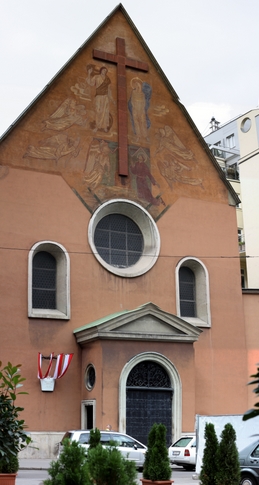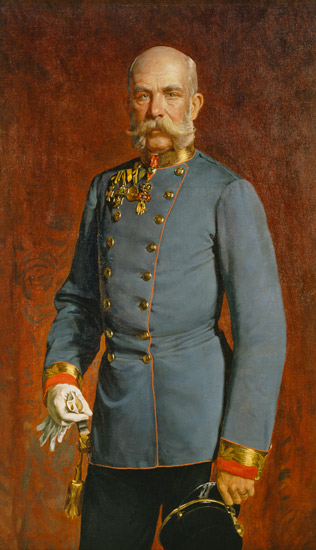The Traditional Burial Ceremony of a Hapsburg Prince
This traditional ceremony for the burial of Hapsburg emperors and princes is a glorious specimen of the profound influence of Christianity on this “first family of Christendom” and a luminous example of faith for Christians not just in Austria, but throughout the world. It will be used on July 16, 2011 for the burial of HIRH Archduke Otto of Hapsburg-Lorraine.
The Grand Chamberlain knocks three times with a silver cane on the door of the Capuchin convent which contains the Imperial crypt.
The Capuchin porter asks:
– “Who is there?”
The Grand Chamberlain proclaims the name and titles of the deceased Hapsburg emperor:

Empress Zita and her son Crown Prince Otto during the former's coronation as Queen of Hungary in 1916. Painting by Gyula Éder (1875-1935)
– “I am (Name) … Emperor of Austria, Apostolic King of Hungary, King of Bohemia, Dalmatia, Croatia, Slavonia, Galicia, Lodomeria, of Illyria, and King of Jerusalem, Archduke of Austria, Grand Duke of Tuscany and Cracow, Duke of Lorraine , Salzburg, STIR, Carinthia, of Carniola and Bukovina, Grand Prince of Transylvania, Margrave of Moravia, Duke of Upper Silesia, Lower Silesia, of Modena, Parma, Piacenza and Guastalla, of Auschwitz and Zator of Ticino, Friuli, Ragusa and Zara, Prince of Conde-Hapsburg and Tyrol, of Kyburg, in Goritz and Gradisca, Prince of Trent and Brixen, Margrave of Upper and Lower Lusatia and Istria, Earl of Hohenembs of Feldkirch of Brigance, in Sonnenberg, Lord of Trieste, of Cattaro and Marche, Great Voivode of Serbia, etc. … ”
Upon hearing this, the porter refuses to open the door and says:
– “I do not know you.”
The Grand Chamberlain knocks on the door again and in answer to the porter’s question “Who is there?” gives just the name of the deceased prince:
– “I am (Name) … His Majesty the Emperor and the King. ”
The porter again refuses admission:
– “I do not know you.”
For a third time, the Grand Chamberlain knocks on the door and the porter asks anew, “Who is there?”
This time, the Grand Chamberlain simply says:
– “I am (Name)… a poor mortal and a sinner.”
To this, the Capuchin friar responds:
– “Come in.”

Main entrance to the Capuchin friary that contains the Imperial Crypt in Vienna. Photo by Politikaner
The convent doors open wide and the casket is carried in, being received by a double row of Capuchin friars.
A funeral oration in the chapel follows, and then the casket is taken to the crypt.
A salvo of 21 cannon shots is heard in Vienna as the coffin enters forever in the sacred crypt.
Nobility.org Editorial comment: —
This Habsburg burial ceremony, consecrated into a revered tradition through use over many generations, is a last and sublime lesson of Christian humility that a Habsburg gives to Catholic peoples.
The contrast between the Habsburg Imperial magnificence and the radical poverty of the Capuchin Order is echoed throughout the short dialogue as the majestic titles are nobly proclaimed only to be met with successive refusals of admission to Christian burial.
It is only when the Grand Chamberlain mentions our common lot of sinners needing the supernatural grace and redeeming merits flowing from the sacrifice of Our Divine Savior on the Cross that the heavy monastery doors swing open in mercy and forgiveness.
“A contrite and humbled heart, O God, Thou wilt not despise.” (Psalm 50:19)











